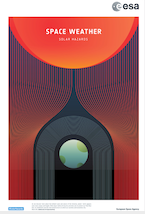Speaker
Description
The ability to monitor space weather is of key importance in protecting infrastructure from its adverse effects, both in space and on the ground. Moreover, the risks associated with space weather are the subject of growing societal interest, following the realisation that severe space weather can deliver significant socio-economic impact through a variety of mechanisms. Space weather monitoring requires a variety of in-situ measurements at many points simultaneously (analogous to weather stations on the ground) Consequently, to ensure European resilience to threats from the Sun by 2030, ESA has formulated within the Space Safety and Security Programme a plan which envisages a heterogenous space-based system using dedicated platforms, hosted payloads, and small satellites.
In many cases, knowledge of the local magnetic field strength and orientation is crucial to understanding and predicting space weather phenomena. Here we discuss how different measurement technologies can be appropriate for different applications and platforms, derived from the experience of designing, building and operating science missions with similar measurement requirements. We focus on the usefulness and applicability of both fluxgate and anisotropic magnetoresistive (AMR) sensor technologies.
Fluxgate magnetometers are typically used in science missions where stable, high precision measurements are required. This stability and reliability make them the best candidate for operational space weather missions such as LAGRANGE, which has stringent requirements on instrument reliability, data availability and data latency. Imperial College London is developing the magnetometer for this mission in collaboration with IWF Graz, and we discuss its current status and lessons learned regarding the transition from science to operational space weather instrumentation.
In contrast, AMR sensors become relevant when mass, volume and power budgets are limited. This is the case of CubeSat and small-sat platforms, which represent an interesting solution to be exploited for space weather monitoring constellation missions, and fractionated observatories. At Imperial College London we have developed MAGIC, a miniaturised magnetometer, which optimises the noise performance while minimising the power consumption by utilising a hybrid AMR sensor triad. This solution has flown on three CubeSat (TRIO-CINEMA) up-to-date and an improved design was developed for the Sunjammer microsatellite. The next mission is the ESA RADCUBE CubeSat and we discuss the current status of the instrument.
Finally, in the context of the D3S programme we consider how these different sensor options can be integrated into the envisaged heterogenous system and potential opportunities and pitfalls.

